Xiao-Yu Zhang
Second FRCSyn-onGoing: Winning Solutions and Post-Challenge Analysis to Improve Face Recognition with Synthetic Data
Dec 02, 2024Abstract:Synthetic data is gaining increasing popularity for face recognition technologies, mainly due to the privacy concerns and challenges associated with obtaining real data, including diverse scenarios, quality, and demographic groups, among others. It also offers some advantages over real data, such as the large amount of data that can be generated or the ability to customize it to adapt to specific problem-solving needs. To effectively use such data, face recognition models should also be specifically designed to exploit synthetic data to its fullest potential. In order to promote the proposal of novel Generative AI methods and synthetic data, and investigate the application of synthetic data to better train face recognition systems, we introduce the 2nd FRCSyn-onGoing challenge, based on the 2nd Face Recognition Challenge in the Era of Synthetic Data (FRCSyn), originally launched at CVPR 2024. This is an ongoing challenge that provides researchers with an accessible platform to benchmark i) the proposal of novel Generative AI methods and synthetic data, and ii) novel face recognition systems that are specifically proposed to take advantage of synthetic data. We focus on exploring the use of synthetic data both individually and in combination with real data to solve current challenges in face recognition such as demographic bias, domain adaptation, and performance constraints in demanding situations, such as age disparities between training and testing, changes in the pose, or occlusions. Very interesting findings are obtained in this second edition, including a direct comparison with the first one, in which synthetic databases were restricted to DCFace and GANDiffFace.
Second Edition FRCSyn Challenge at CVPR 2024: Face Recognition Challenge in the Era of Synthetic Data
Apr 16, 2024



Abstract:Synthetic data is gaining increasing relevance for training machine learning models. This is mainly motivated due to several factors such as the lack of real data and intra-class variability, time and errors produced in manual labeling, and in some cases privacy concerns, among others. This paper presents an overview of the 2nd edition of the Face Recognition Challenge in the Era of Synthetic Data (FRCSyn) organized at CVPR 2024. FRCSyn aims to investigate the use of synthetic data in face recognition to address current technological limitations, including data privacy concerns, demographic biases, generalization to novel scenarios, and performance constraints in challenging situations such as aging, pose variations, and occlusions. Unlike the 1st edition, in which synthetic data from DCFace and GANDiffFace methods was only allowed to train face recognition systems, in this 2nd edition we propose new sub-tasks that allow participants to explore novel face generative methods. The outcomes of the 2nd FRCSyn Challenge, along with the proposed experimental protocol and benchmarking contribute significantly to the application of synthetic data to face recognition.
* arXiv admin note: text overlap with arXiv:2311.10476
Learning Spatiotemporal Inconsistency via Thumbnail Layout for Face Deepfake Detection
Mar 20, 2024



Abstract:The deepfake threats to society and cybersecurity have provoked significant public apprehension, driving intensified efforts within the realm of deepfake video detection. Current video-level methods are mostly based on {3D CNNs} resulting in high computational demands, although have achieved good performance. This paper introduces an elegantly simple yet effective strategy named Thumbnail Layout (TALL), which transforms a video clip into a pre-defined layout to realize the preservation of spatial and temporal dependencies. This transformation process involves sequentially masking frames at the same positions within each frame. These frames are then resized into sub-frames and reorganized into the predetermined layout, forming thumbnails. TALL is model-agnostic and has remarkable simplicity, necessitating only minimal code modifications. Furthermore, we introduce a graph reasoning block (GRB) and semantic consistency (SC) loss to strengthen TALL, culminating in TALL++. GRB enhances interactions between different semantic regions to capture semantic-level inconsistency clues. The semantic consistency loss imposes consistency constraints on semantic features to improve model generalization ability. Extensive experiments on intra-dataset, cross-dataset, diffusion-generated image detection, and deepfake generation method recognition show that TALL++ achieves results surpassing or comparable to the state-of-the-art methods, demonstrating the effectiveness of our approaches for various deepfake detection problems. The code is available at https://github.com/rainy-xu/TALL4Deepfake.
Exploring Straighter Trajectories of Flow Matching with Diffusion Guidance
Nov 28, 2023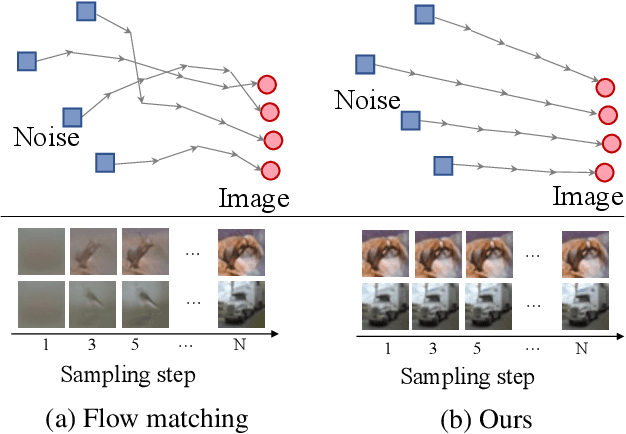

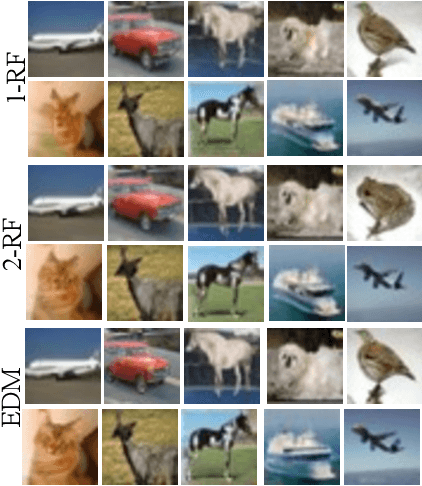
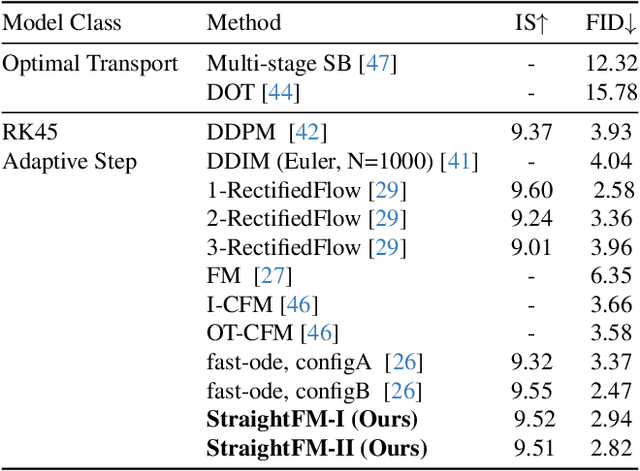
Abstract:Flow matching as a paradigm of generative model achieves notable success across various domains. However, existing methods use either multi-round training or knowledge within minibatches, posing challenges in finding a favorable coupling strategy for straight trajectories. To address this issue, we propose a novel approach, Straighter trajectories of Flow Matching (StraightFM). It straightens trajectories with the coupling strategy guided by diffusion model from entire distribution level. First, we propose a coupling strategy to straighten trajectories, creating couplings between image and noise samples under diffusion model guidance. Second, StraightFM also integrates real data to enhance training, employing a neural network to parameterize another coupling process from images to noise samples. StraightFM is jointly optimized with couplings from above two mutually complementary directions, resulting in straighter trajectories and enabling both one-step and few-step generation. Extensive experiments demonstrate that StraightFM yields high quality samples with fewer step. StraightFM generates visually appealing images with a lower FID among diffusion and traditional flow matching methods within 5 sampling steps when trained on pixel space. In the latent space (i.e., Latent Diffusion), StraightFM achieves a lower KID value compared to existing methods on the CelebA-HQ 256 dataset in fewer than 10 sampling steps.
FRCSyn Challenge at WACV 2024:Face Recognition Challenge in the Era of Synthetic Data
Nov 17, 2023



Abstract:Despite the widespread adoption of face recognition technology around the world, and its remarkable performance on current benchmarks, there are still several challenges that must be covered in more detail. This paper offers an overview of the Face Recognition Challenge in the Era of Synthetic Data (FRCSyn) organized at WACV 2024. This is the first international challenge aiming to explore the use of synthetic data in face recognition to address existing limitations in the technology. Specifically, the FRCSyn Challenge targets concerns related to data privacy issues, demographic biases, generalization to unseen scenarios, and performance limitations in challenging scenarios, including significant age disparities between enrollment and testing, pose variations, and occlusions. The results achieved in the FRCSyn Challenge, together with the proposed benchmark, contribute significantly to the application of synthetic data to improve face recognition technology.
Learning Cross-modality Information Bottleneck Representation for Heterogeneous Person Re-Identification
Aug 29, 2023



Abstract:Visible-Infrared person re-identification (VI-ReID) is an important and challenging task in intelligent video surveillance. Existing methods mainly focus on learning a shared feature space to reduce the modality discrepancy between visible and infrared modalities, which still leave two problems underexplored: information redundancy and modality complementarity. To this end, properly eliminating the identity-irrelevant information as well as making up for the modality-specific information are critical and remains a challenging endeavor. To tackle the above problems, we present a novel mutual information and modality consensus network, namely CMInfoNet, to extract modality-invariant identity features with the most representative information and reduce the redundancies. The key insight of our method is to find an optimal representation to capture more identity-relevant information and compress the irrelevant parts by optimizing a mutual information bottleneck trade-off. Besides, we propose an automatically search strategy to find the most prominent parts that identify the pedestrians. To eliminate the cross- and intra-modality variations, we also devise a modality consensus module to align the visible and infrared modalities for task-specific guidance. Moreover, the global-local feature representations can also be acquired for key parts discrimination. Experimental results on four benchmarks, i.e., SYSU-MM01, RegDB, Occluded-DukeMTMC, Occluded-REID, Partial-REID and Partial\_iLIDS dataset, have demonstrated the effectiveness of CMInfoNet.
Rumor Detection with Diverse Counterfactual Evidence
Jul 18, 2023



Abstract:The growth in social media has exacerbated the threat of fake news to individuals and communities. This draws increasing attention to developing efficient and timely rumor detection methods. The prevailing approaches resort to graph neural networks (GNNs) to exploit the post-propagation patterns of the rumor-spreading process. However, these methods lack inherent interpretation of rumor detection due to the black-box nature of GNNs. Moreover, these methods suffer from less robust results as they employ all the propagation patterns for rumor detection. In this paper, we address the above issues with the proposed Diverse Counterfactual Evidence framework for Rumor Detection (DCE-RD). Our intuition is to exploit the diverse counterfactual evidence of an event graph to serve as multi-view interpretations, which are further aggregated for robust rumor detection results. Specifically, our method first designs a subgraph generation strategy to efficiently generate different subgraphs of the event graph. We constrain the removal of these subgraphs to cause the change in rumor detection results. Thus, these subgraphs naturally serve as counterfactual evidence for rumor detection. To achieve multi-view interpretation, we design a diversity loss inspired by Determinantal Point Processes (DPP) to encourage diversity among the counterfactual evidence. A GNN-based rumor detection model further aggregates the diverse counterfactual evidence discovered by the proposed DCE-RD to achieve interpretable and robust rumor detection results. Extensive experiments on two real-world datasets show the superior performance of our method. Our code is available at https://github.com/Vicinity111/DCE-RD.
Cross Architecture Distillation for Face Recognition
Jun 26, 2023Abstract:Transformers have emerged as the superior choice for face recognition tasks, but their insufficient platform acceleration hinders their application on mobile devices. In contrast, Convolutional Neural Networks (CNNs) capitalize on hardware-compatible acceleration libraries. Consequently, it has become indispensable to preserve the distillation efficacy when transferring knowledge from a Transformer-based teacher model to a CNN-based student model, known as Cross-Architecture Knowledge Distillation (CAKD). Despite its potential, the deployment of CAKD in face recognition encounters two challenges: 1) the teacher and student share disparate spatial information for each pixel, obstructing the alignment of feature space, and 2) the teacher network is not trained in the role of a teacher, lacking proficiency in handling distillation-specific knowledge. To surmount these two constraints, 1) we first introduce a Unified Receptive Fields Mapping module (URFM) that maps pixel features of the teacher and student into local features with unified receptive fields, thereby synchronizing the pixel-wise spatial information of teacher and student. Subsequently, 2) we develop an Adaptable Prompting Teacher network (APT) that integrates prompts into the teacher, enabling it to manage distillation-specific knowledge while preserving the model's discriminative capacity. Extensive experiments on popular face benchmarks and two large-scale verification sets demonstrate the superiority of our method.
Grouped Knowledge Distillation for Deep Face Recognition
Apr 10, 2023Abstract:Compared with the feature-based distillation methods, logits distillation can liberalize the requirements of consistent feature dimension between teacher and student networks, while the performance is deemed inferior in face recognition. One major challenge is that the light-weight student network has difficulty fitting the target logits due to its low model capacity, which is attributed to the significant number of identities in face recognition. Therefore, we seek to probe the target logits to extract the primary knowledge related to face identity, and discard the others, to make the distillation more achievable for the student network. Specifically, there is a tail group with near-zero values in the prediction, containing minor knowledge for distillation. To provide a clear perspective of its impact, we first partition the logits into two groups, i.e., Primary Group and Secondary Group, according to the cumulative probability of the softened prediction. Then, we reorganize the Knowledge Distillation (KD) loss of grouped logits into three parts, i.e., Primary-KD, Secondary-KD, and Binary-KD. Primary-KD refers to distilling the primary knowledge from the teacher, Secondary-KD aims to refine minor knowledge but increases the difficulty of distillation, and Binary-KD ensures the consistency of knowledge distribution between teacher and student. We experimentally found that (1) Primary-KD and Binary-KD are indispensable for KD, and (2) Secondary-KD is the culprit restricting KD at the bottleneck. Therefore, we propose a Grouped Knowledge Distillation (GKD) that retains the Primary-KD and Binary-KD but omits Secondary-KD in the ultimate KD loss calculation. Extensive experimental results on popular face recognition benchmarks demonstrate the superiority of proposed GKD over state-of-the-art methods.
MetaTKG: Learning Evolutionary Meta-Knowledge for Temporal Knowledge Graph Reasoning
Feb 02, 2023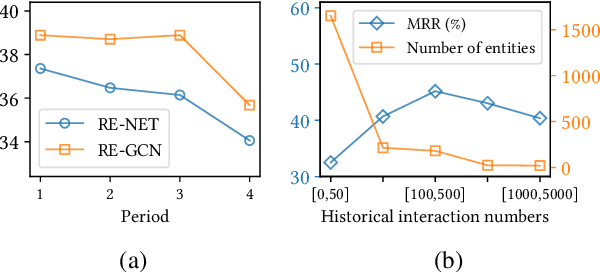
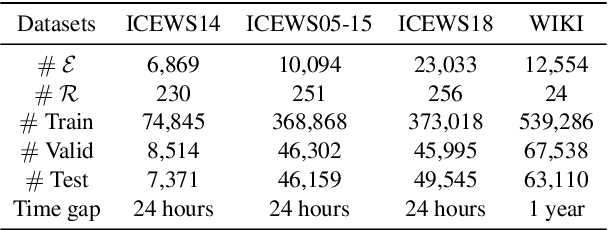
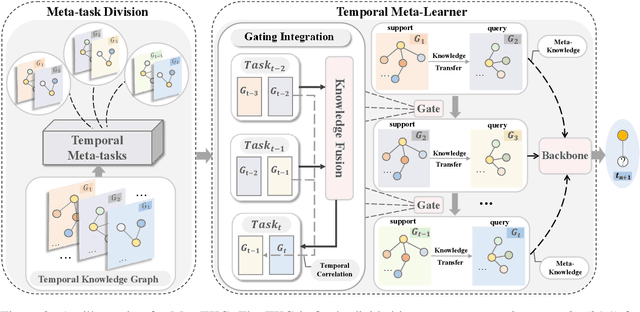
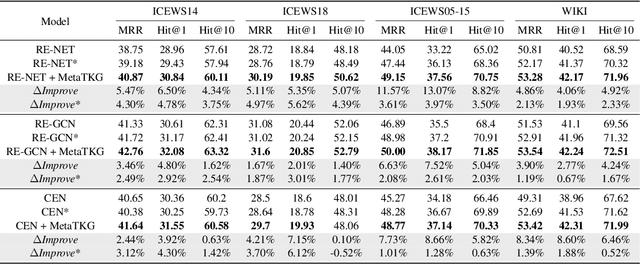
Abstract:Reasoning over Temporal Knowledge Graphs (TKGs) aims to predict future facts based on given history. One of the key challenges for prediction is to learn the evolution of facts. Most existing works focus on exploring evolutionary information in history to obtain effective temporal embeddings for entities and relations, but they ignore the variation in evolution patterns of facts, which makes them struggle to adapt to future data with different evolution patterns. Moreover, new entities continue to emerge along with the evolution of facts over time. Since existing models highly rely on historical information to learn embeddings for entities, they perform poorly on such entities with little historical information. To tackle these issues, we propose a novel Temporal Meta-learning framework for TKG reasoning, MetaTKG for brevity. Specifically, our method regards TKG prediction as many temporal meta-tasks, and utilizes the designed Temporal Meta-learner to learn evolutionary meta-knowledge from these meta-tasks. The proposed method aims to guide the backbones to learn to adapt quickly to future data and deal with entities with little historical information by the learned meta-knowledge. Specially, in temporal meta-learner, we design a Gating Integration module to adaptively establish temporal correlations between meta-tasks. Extensive experiments on four widely-used datasets and three backbones demonstrate that our method can greatly improve the performance.
 Add to Chrome
Add to Chrome Add to Firefox
Add to Firefox Add to Edge
Add to Edge